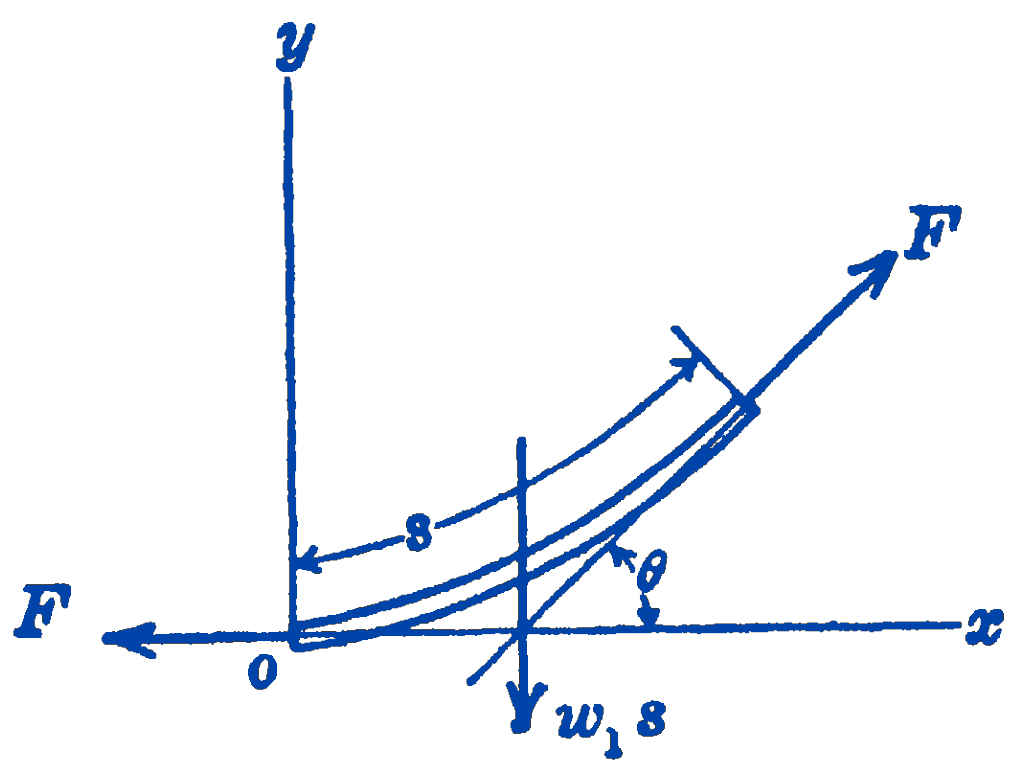In some cases the load acting on a flexible cable is uniformly distributed along the length of the cable rather than along the horizontal. This is always the situation when the major load on the cable is its own weight, as for an electrical transmission line. In this problem the same differential equation derived above is valid: \[ \frac{d y}{d x}=\frac{W}{F_{h}} \] where now \[ W=w_{1} s \] where \(w_{1}\) is the weight per unit length of the cable, and \(s\) is the length of the cable from the lowest point to the point \(x, y\).

Expressing \(s\) in terms of \(x\) and \(y\) we have: \[ \frac{d s}{d x}=\sqrt{1+\left(\frac{d y}{d x}\right)^{2}}. \]
Since \[ \frac{d y}{d x}=\frac{w_{1} s}{F_{h}} \] this becomes \[ \begin{aligned} \frac{d s}{d x} & =\sqrt{1+\left(\frac{w_{1} s}{F_{h}}\right)^{2}} \\ x & =\int \frac{d s}{\sqrt{1+\left(\dfrac{w_{1} s}{F_{h}}\right)^{2}}} \end{aligned} \] From the integral tables we find: \[ x=\frac{F_{h}}{w_{1}} \sinh ^{-1} \frac{w_{1} s}{F_{h}}+C_{1} \]
when \(x=0, s=0\), therefore \(C_{1}=0\). Thus \[ \frac{w_{1} s}{F_{h}}=\sinh \frac{w_{1} x}{F_{h}} ; \quad s=\frac{F_{h}}{w_{1}} \sinh \frac{w_{1} x}{F_{h}} \]
Substituting this into the original differential equation, we get: \[ \begin{aligned} \frac{d y}{d x} & =\sinh \frac{w_{1} x}{F_{h}} \\ y & =\int \sinh \frac{w_{1} x}{F_{h}} d x=\frac{F_{h}}{w_{1}} \cosh \frac{w_{1} x}{F_{h}}+C_{2} \end{aligned} \] when \(x=0, y=0\) \[ 0=\frac{F_{h}}{w_{1}} \cosh 0+C_{2} ; \quad C_{2}=-\frac{F_{h}}{w_{1}} \ \] hence \[ \bbox [5px,border:1px #f2f2f2;background-color:#f2f2f2]{y=\frac{F_{h}}{w_{1}}\left(\cosh \frac{w_{1} x}{F_{h}}-1\right).} \] This equation gives the curve which will be assumed by the flexible cable hanging under its own weight. Such a curve is called a catenary.
The force in the cable can be found in the same way as for the parabolic cable, Equation (2) of the previous section becoming: \[ F=\sqrt{F_{h}^{2}+w_{1}^{2} s^{2}}=F_{h} \sqrt{1+\sinh ^{2} \frac{w_{1} x}{F_{h}}} \] since \[ \cosh ^{2} \alpha-\sinh ^{2} \alpha=1 \] this gives: \[ F=F_{h} \cosh \frac{w_{1} x}{F_{h}} \] for the case of a cable suspended from two supports at the same level. The maximum force will occur at the support, where \(x=\dfrac{l}{2}\), so \[ F_{\max }=F_{h} \cosh \frac{w_{1} l}{2 F_{h}} \] To find \(F_{h}\) we note that when \(x=\frac{l}{2}, y=f\). Introducing these values into the equation relating \(x\) and \(y\) gives: \[ f=\frac{F_{h}}{w_{1}}\left(\cosh \frac{w_{1} l}{2 F_{h}}-1\right) \]
This equation can in most practical problems be solved easily by trial and error.
6.15.1 PROBLEMS
1. A cable 1000 ft long which weighs 2 lb per ft is to be suspended from two points at the same level. If the force in the cable is to be limited to 2000 lb , what should be the span?
Answer
950 ft
2. Compute the sag for the cable of Problem 172 above. Find the maximum force in this cable, for the computed span and sag, by assuming that the total weight of the cable is uniformly distributed horizontally, and compare this with the actual force.
Answer
\(133 \ \mathrm{ft} ; 2045 \ \mathrm{lb}\)
3. A cable weighing 3 lb per ft is stretched between two points on the same level 1000 ft apart. The sag is 100 ft . Find the maximum tension in the cable, and the length of the cable. (Note: This problem requires a trial and error solution.)
Answer
\(4050 \ \mathrm{lb} ; 1025 \ \mathrm{ft}\)
4. A transmission line is to be strung with a minimum clearance of 30 ft to the ground. The wire used weighs \(\frac{1}{2} \mathrm{lb}\) per ft , and the maximum permissible tension force is 1000 lb . If the towers are 40 ft high, how far apart should they be?
Answer
398 ft
5. A flexible cable 300 ft long weighs 1 lb per ft . The cable is suspended from two supports at the same level that are 200 ft apart. Find the sag of the cable and the maximum force in the cable.
Answer
\(101 \ \mathrm{ft} ; 162 \ \mathrm{lb}\)
6. In the formula derived above for the relationship between \(x\) and \(y\) for the catenary cable, show that if the first two terms only of the series expansion for the hyperbolic cosine are retained, the expression becomes identical to that found for the parabolic cable.